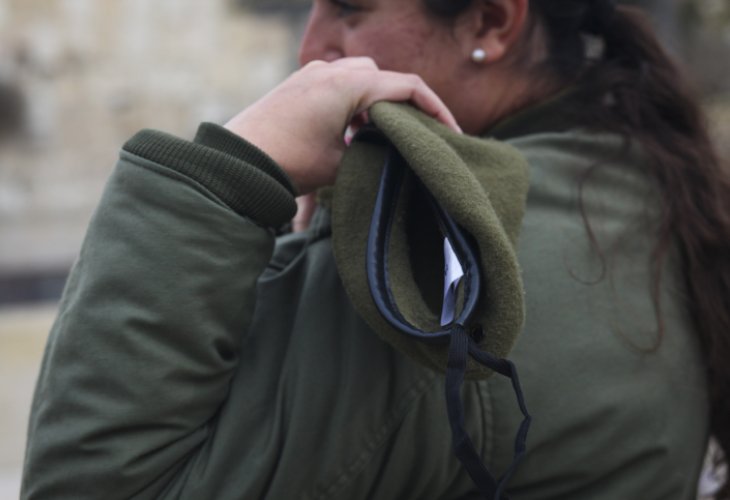Personal Stories
From the Army to the Synagogue: Ida’s Journey Home
A secular Israeli girl finds her way to Judaism through Shabbat, prayer, and deep inner conviction.
 (Illustration: Flash 90)
(Illustration: Flash 90)Even though she didn’t call Him “Hashem,” Ida Sagiv always felt there was a higher power guiding the world. She wasn’t raised in a religious family, but from a young age, she would lift her eyes to the heavens and speak to Him in her own words.
“I knew almost nothing about Shabbat,” recalls Ida, now 36, a photographer and mother of four daughters living in Elad. “I just knew we didn’t make omelets on Shabbat. But we still used the oven and listened to music quietly. We didn’t eat pork or shellfish, but we didn’t pay attention to kosher certification either. That was the extent of it.”
Even at five years old, she would pull a blanket over her head and whisper heartfelt words to her “best friend in the sky.” Something deep inside told her that one day she would live a life of Torah and mitzvot.
That day came when she was in ninth grade. A friend’s father had tragically drowned on Shabbat, and in his memory, the friend committed to keeping Shabbat for a year. When the year was up, the friend told Ida she was finished. Ida responded, “You promised. You can’t stop now.” Her friend insisted, so Ida surprised herself by saying, “Fine. I’ll keep Shabbat in your place.”
She meant it.
The idea seemed random at first. But that very Shabbat, she called an aunt who had become religious and asked if she could join her. “I was addicted to TV,” Ida admits. “I thought I’d never survive it. But Hashem sent me a beautiful Shabbat with a cantor whose melodies touched my soul. I felt elevated the entire time.”
When Shabbat ended, she called her mother and declared, “From now on, I’m keeping Shabbat. Let’s get a hot plate and an urn.”
From that point on, she began keeping mitzvot but with no guidance. “Looking back, I realize how unusual I was. I’d leave three TVs on before Shabbat so I wouldn’t have to touch the remote. I didn’t realize that even turning them on before Shabbat was still a problem.”
Ida did her best to grow in her own way. “I didn’t know there were prayer books. I followed my heart. If something inspired me, I added it to my list of mitzvot.”
She once met a secular woman who said the blessing after using the bathroom—Asher Yatzar. Ida was fascinated. The woman wrote it on a note, and Ida memorized it every night until she could say it by heart.
In tenth grade, she decided to pray three times a day. “I saw another girl in my class quietly davening, and she inspired me.” Even when she went to the beach, she would step aside and pray. “I didn’t think I was religious. I wore pants and acted like everyone else. But in my heart, I was deeply connected to Hashem.”
When she enlisted in the army, she hoped to maintain her spiritual path. After her father passed away a month before, many discouraged her, warning it would be too hard to stay religious. But she wanted to serve her country.
During basic training, she managed to pray three times a day and was respected during fast days. But when she was transferred to the Tel Hashomer base, things changed. Her commander was strongly anti-religious. “He hated everything about Torah observance,” Ida remembers. “One day, I was saying Birkat Hamazon (Grace After Meals) and couldn’t answer the phone. A friend offered to, but the commander refused. He shouted at me in front of everyone, ‘This is the army, not a synagogue!’ He kept harassing me after that.”
Feeling crushed, Ida turned to Hashem. “I prayed and cried: if I’m not supposed to be here, take me out. And if I am, help me stay strong.”
Eventually, she realized it was time to leave and applied for a discharge on religious grounds. “Everyone said I didn’t stand a chance. I barely knew any halachah and didn’t think I had what it took.”
At the discharge hearing, they asked her questions she wasn’t prepared for: “What’s this week’s Torah portion? Where do you study?” She simply said, “I don’t study. I’m in the army.”
Still, Hashem helped. Her discharge was approved. Her mother couldn’t believe it. “Girls came out of that room crying,” she said. “And you came out smiling.”
As a sign of thanks to Hashem, Ida decided to strengthen her modesty. She began wearing skirts and socks. “I felt like my soul had been freed from a prison.”
Ida later attended a seminary for women who had returned to Judaism in Jerusalem. She studied there for three years and eventually met her husband through a shadchan (matchmaker). Today, they live a full Haredi life, and all their daughters study in Torah schools.
“Looking back, I see that even when I was that ‘strange bird,’ Hashem was always with me. Life still has challenges but when you’re walking with Hashem, everything becomes easier to handle.”

